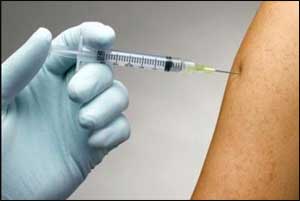- Home
- Editorial
- News
- Practice Guidelines
- Anesthesiology Guidelines
- Cancer Guidelines
- Cardiac Sciences Guidelines
- Critical Care Guidelines
- Dentistry Guidelines
- Dermatology Guidelines
- Diabetes and Endo Guidelines
- Diagnostics Guidelines
- ENT Guidelines
- Featured Practice Guidelines
- Gastroenterology Guidelines
- Geriatrics Guidelines
- Medicine Guidelines
- Nephrology Guidelines
- Neurosciences Guidelines
- Obs and Gynae Guidelines
- Ophthalmology Guidelines
- Orthopaedics Guidelines
- Paediatrics Guidelines
- Psychiatry Guidelines
- Pulmonology Guidelines
- Radiology Guidelines
- Surgery Guidelines
- Urology Guidelines
A cancer vaccine successfully developed by Scientists

Stanford researchers have been able to eliminate all traces of cancer in mice by injecting minute amounts of two immune- stimulating agents directly into solid tumours.One of the agents is already approved for use in humans and the other has been tested for human use in several unrelated clinical trials, researchers said.This has raised hopes for development of a cancer vaccine for humans.
The approach works for many different types of cancers, including those that arise spontaneously, the study found.
The local application of very small amounts of the agents could serve as a rapid and relatively inexpensive cancer therapy that is unlikely to cause the adverse side effects often seen with body-wide immune stimulation, researchers said.
"When we use these two agents together, we see the elimination of tumours all over the body," said Ronald Levy, professor at Stanford University School of Medicine in the US.
"This approach bypasses the need to identify tumour- specific immune targets and does not require wholesale activation of the immune system or customisation of a patients immune cells," said Levy, senior author of the study published in the journal Science Translational Medicine.
A clinical trial was launched in January to test the effect of the treatment in patients with lymphoma.
Cancers often exist in a strange kind of limbo with regard to the immune system, researchers said.
Immune cells like T cells recognise the abnormal proteins often present on cancer cells and infiltrate to attack the tumour.
However, as the tumour grows, it often devises ways to suppress the activity of the T cells.
The new method works to reactivate the cancer-specific T cells by injecting microgramme amounts of two agents directly into the tumour site.
One, a short stretch of DNA called a CpG oligonucleotide, works with other nearby immune cells to amplify the expression of an activating receptor called OX40 on the surface of the T cells.
The other, an antibody that binds to OX40, activates the T cells to lead the charge against the cancer cells.
Since the two agents are injected directly into the tumour, only T cells that have infiltrated it are activated.
In effect, these T cells are "prescreened" by the body to recognise only cancer-specific proteins, researchers said.
Some of these tumour-specific, activated T cells then leave the original tumour to find and destroy other identical tumours throughout the body, they said.

Disclaimer: This site is primarily intended for healthcare professionals. Any content/information on this website does not replace the advice of medical and/or health professionals and should not be construed as medical/diagnostic advice/endorsement or prescription. Use of this site is subject to our terms of use, privacy policy, advertisement policy. © 2020 Minerva Medical Treatment Pvt Ltd